Efficiently managing employee time off is crucial for maintaining productivity, compliance, and employee satisfaction in any organization. Leave management software simplifies the process by automating time off requests, tracking accruals, and ensuring compliance with company policies and labor laws. One of the best solutions on the market is Day Off, an intuitive and user-friendly app designed to streamline leave tracking for businesses of all sizes. In this article, we’ll explore Day Off and other top leave management software options to help you streamline your leave processes and enhance overall workforce management.
1. Day Off
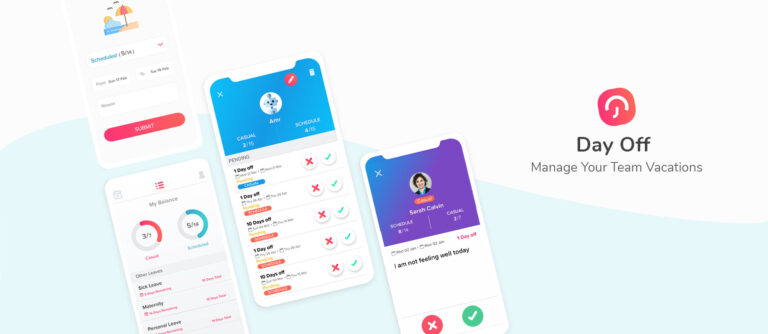
Key Features
Workflow
HR Dashboard
best price
$1 Employee / Month • Trial: Yes • Free Plan: Yes.
Pros
User-Friendly Interface: The app is designed to be intuitive and easy to navigate.
Customizable: Flexible leave policies tailored to different companies or teams.
Efficient Leave Management: Reduces paperwork and automates the leave approval process.
Visibility: Managers can see a comprehensive view of the team’s leave schedule, helping in planning.
Mobile Access: Employees can request and view leave from anywhere using their mobile devices.
Leave Balance Tracking: Employees can check their remaining leave balances at any time.
Boosts Employee Satisfaction: Transparency in leave management enhances employee trust.
Cons
Limited Offline Access: Requires internet connectivity to access features and data.
Scaling for Larger Organizations: May not be as robust for managing very large teams with complex leave structures.

Key Features
- Payroll Automation: Streamlines the payroll process—from calculations and statutory compliance to salary disbursements—minimizing manual interventions.
- Time & Attendance: Monitors employee check-ins and check-outs with real-time tracking, biometric integrations, and geolocation support for field staff.
- Employee Self-Service: Empowers employees to view payslips, submit leave requests, track attendance records, and update personal information independently.
- Leave Management: Simplifies vacation and time-off tracking with customizable leave policies, automated approval workflows, and balance notifications.
- Performance Management: It sets goals for teams. It collects 360° feedback. It runs review cycles. It keeps managers and employees on track.
- Travel & Expense Tracking: It tracks business travel costs. It lets employees file, approve, and reimburse expenses. It stores digital receipts.
- Compliance Management: It checks labor laws and tax rules. It updates payroll and documents to meet local rules.
- Mobile App: It provides access to HR features on the move. Employees check attendance, request leave, and approve expenses.
- Analytics & Reporting: It shows clear insights on workforce data. It displays dashboards and reports that guide decisions.
- Integrations: It connects with accounting systems, ERP, and HR tools. It keeps data in sync.
Workflow
HR Dashboard
Trial: Yes • Free Plan: No • Contact the team for accurate pricing
Pros
HR Suite: Combines payroll, leave, performance, and expense management on one platform.
Self-Service Portal: Allows employees to complete basic tasks via the dedicated mobile app and self-service portal.
Real-Time Attendance: It uses AI-facial recognition and geo-fencing data for attendance tracking.
Automated Payroll: It reduces the required manual work and ensures accurate salary payments.
Compliance: Will help you to adhere to the labor laws and tax rules consistently.
Analytics: Provides clear insights through dashboards and reports.
Mobile Access: Offers access to key HR functions on the move.
Cons
Complex Initial Setup: Integration with existing systems may require technical expertise and additional time.
Higher Cost for Smaller Teams: Pricing might be less competitive for startups or small organizations.
Limited Niche Customization: Certain modules may offer fewer options than specialized HR tools.
Internet Dependency: Uninterrupted access relies on a stable internet connection as a cloud-based solution.
Learning Curve for Advanced Features: Fully leveraging the extensive functionalities may necessitate user training.
3. Zoho People
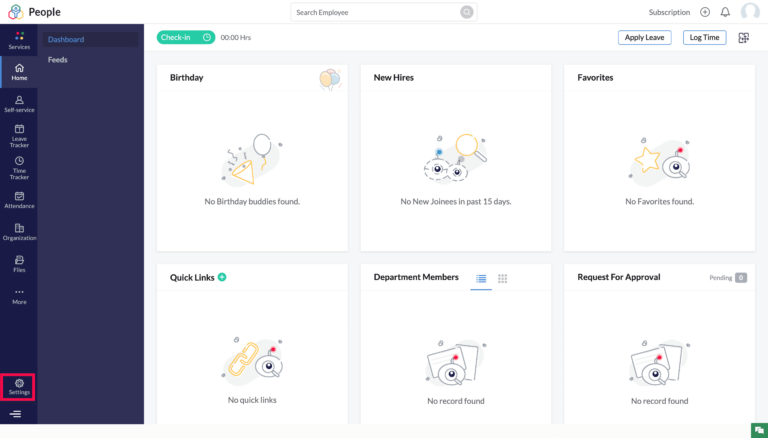
Key Features
- Employee Database Management: Centralized system to store and manage employee records, including personal and professional information.
- Leave and Attendance Management: Tracks employee attendance, leave requests, approvals, and balances with customizable policies.
- Performance Management: Facilitates goal-setting, 360-degree feedback, and performance appraisals with a user-friendly interface.
- Time Tracking: Tracks employee work hours and project timesheets, with integration for billing and payroll.
- Employee Self-Service: Employees can update personal details, apply for leaves, view attendance, and access their payslips through a self-service portal.
- HR Workflows Automation: Automates HR processes like onboarding, approvals, document management, and performance reviews.
- Customizable Forms: Allows creating custom forms to gather data or requests, which can be used for surveys, feedback, and more.
- Mobile App: Employees and managers can access HR functionalities like leave requests, timesheets, and approvals on the go via the mobile app.
- HR Analytics and Reporting: Provides insights into employee data through customizable reports and dashboards for better decision-making.
- Integration with Other Zoho Apps: Seamlessly integrates with other Zoho products like Zoho Payroll, Zoho Expense, and third-party apps.
Workflow
HR Dashboard
$1 to $4 per employee per month • Trial: Yes • Free Plan: Yes.
Pros
Affordable Pricing: Offers a cost-effective HR solution with flexible pricing plans suitable for small and medium-sized businesses.
Easy to Use: Intuitive interface and easy navigation make it accessible for HR teams and employees alike.
Customizability: Highly customizable workflows, forms, and modules to adapt to the unique needs of businesses.
Comprehensive HR Suite: Covers most HR tasks, including attendance, performance management, and time tracking in a single platform.
Mobile Accessibility: The mobile app provides flexibility and convenience for users to manage tasks on the go.
Seamless Integration: Integrates with other Zoho apps and external tools, providing a connected ecosystem for businesses.
Automation Capabilities: Automates repetitive HR processes, saving time and reducing manual efforts.
Employee Self-Service: Empowers employees to manage their own profiles, leave requests, and time tracking, reducing the burden on HR teams.
Cons
Limited Advanced Features: While it covers essential HR tasks, it may lack more advanced features required by large enterprises.
Reporting Complexity: Some users report that customizing reports and analytics can be a bit complex or limited in flexibility.
Customer Support: Support response times and quality can vary, and some users have experienced slow resolutions to issues.
Learning Curve for Customization: Although it offers a lot of customization, setting up complex workflows or configurations may require some technical knowledge.
Mobile App Limitations: While functional, the mobile app has fewer features compared to the desktop version, which might limit certain tasks.
Integration Setup: Initial setup and integration with third-party tools can sometimes be challenging, requiring technical assistance.
4. Kissflow HR Cloud
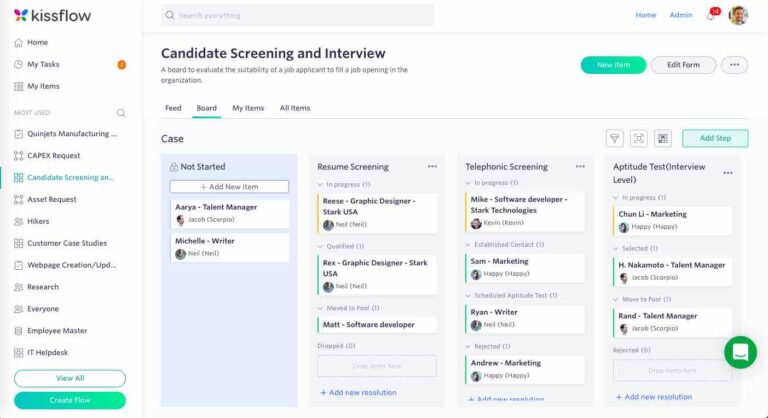
Key Features
Integrationen
Automation
$690 per month • Trial: Yes • Free Plan: No.
Pros
User-Friendly Interface: Intuitive design, making it easy for HR teams and employees to navigate and use the platform.
Customizability: Highly customizable workflows that can adapt to the specific needs of different organizations.
All-in-One Solution: Comprehensive suite covering the entire HR lifecycle, from hiring to offboarding.
Seamless Integration: Integrates with other business applications like payroll systems, ensuring smoother data flow.
Employee Self-Service: Empowers employees to manage their HR requests and access information independently, reducing HR workload.
Automation: Automates repetitive HR tasks like leave requests, onboarding, and performance reviews, improving efficiency.
Cloud-Based: Accessible from anywhere, making it ideal for remote and hybrid workforces.
Analytics and Reports: Provides actionable insights for decision-making through in-depth reports and analytics.
Cons
Cost: Can be expensive for small businesses, especially with its subscription-based pricing model.
Complex Customization: While the platform is customizable, setting up advanced workflows may require technical expertise or additional support.
Limited Payroll Features: While it integrates with payroll systems, Kissflow HR Cloud itself does not offer robust payroll functionalities.
Mobile App Limitations: Some users report that the mobile app lacks certain features available in the web version, which may limit functionality for mobile users.
Learning Curve: Despite its intuitive interface, advanced features and customizations may have a steep learning curve for new users or small HR teams.
Occasional Performance Issues: Some users have reported occasional slowdowns or glitches, particularly when handling large datasets.
5. Timetastic
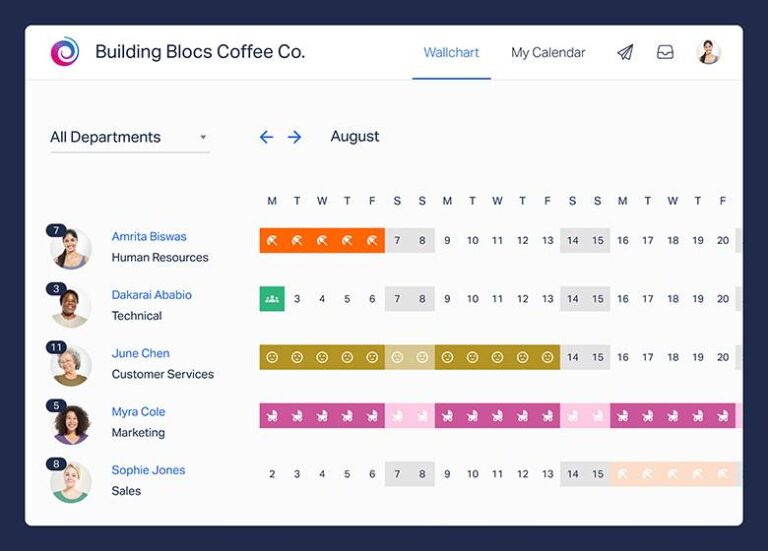
Key Features
Workflow
Integrationen
HR Dashboard
$1.30 to $2.60 per employee per month • Trial: Yes • Free Plan: Yes.
Pros
User-Friendly Interface: Simple and intuitive design, making it easy for both employees and managers to use without extensive training.
Cost-Effective: Affordable for small to medium-sized businesses, with straightforward pricing plans that scale with the number of users.
Quick Setup: Easy to set up and start using, with minimal configuration needed for small teams.
Mobile-Friendly: The mobile app allows users to request and manage leave on the go, which is great for teams that work remotely or travel frequently.
Good Overview of Absences: The wallchart provides a clear visual of who’s on leave, helping managers plan and allocate resources effectively.
Customizable Leave Types: Ability to define custom leave types ensures the system fits the specific needs of different organizations.
Integration with Calendars: Seamless calendar integrations keep team schedules synchronized and make absence planning easier.
No Paperwork: Helps reduce administrative work by offering a fully paperless system for leave management.
Cons
Limited Advanced Features: Lacks more advanced HR features like performance management, payroll integration, or recruiting tools, making it less suitable for large enterprises with complex HR needs.
Basic Reporting: Reporting features are useful but might be too simple for companies needing in-depth analytics on employee absences.
No Multi-Language Support: Limited language options may make it challenging for companies with employees in non-English-speaking regions.
Public Holidays: While it includes public holidays, customization of holiday calendars for different regions may require manual adjustment.
Genehmigungs-Workflow: Some users report that the approval workflow is quite basic, which might be limiting for larger organizations with more complex leave approval processes.
No Payroll Integration: Does not integrate with payroll systems, which can be a drawback for companies seeking an all-in-one HR solution.
6. Absence.io
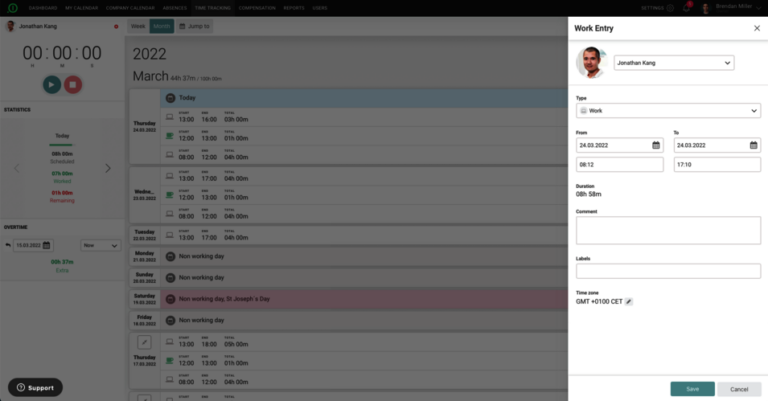
Key Features
HR Dashboard
Mobile App
Integrationen
$2.50 per employee per month • Trial: Yes • Free Plan: No.
Pros
User-Friendly Interface: Easy to navigate, making it accessible for both employees and HR teams without extensive training.
Customizable: Ability to create custom absence types and tailor the system to match the company’s specific policies and needs.
Mobile-Friendly: The mobile app enables employees and managers to manage leave requests and approvals from anywhere.
Centralized HR Management: Combines leave management, time tracking, and employee records in one system, reducing administrative work.
Transparent Leave Tracking: Employees can see a clear breakdown of their leave history and remaining balances, reducing back-and-forth communication.
Integration Capabilities: Works well with other business tools like payroll systems and calendar apps, making data synchronization seamless.
Flexible for Remote Work: Customizable leave types allow companies to track remote work days or other non-standard working arrangements.
Scalable: Suitable for small, medium, and large businesses due to its flexibility and ability to handle large teams.
Cons
Preisgestaltung: May be costly for smaller companies or startups, especially for teams that require advanced features.
Basic Time Tracking: The time tracking feature is not as advanced as some dedicated time-tracking tools, which might be limiting for companies with complex time-tracking needs.
Limited Customization in Reports: While reporting is available, some users report limitations in customizing the reports according to specific organizational needs.
No Built-In Payroll: Unlike some HR software, Absence.io does not have a built-in payroll system, so users need to rely on external integrations.
Occasional Performance Issues: Some users report occasional slowdowns or bugs when managing large amounts of data or when used by large teams.
Language Support: While Absence.io supports multiple languages, some users report that not all aspects of the platform are fully translated, which can be a barrier for non-English-speaking teams.
7. Jibble

Key Features
- Time Tracking: Provides accurate tracking of employee work hours with clock-in/clock-out functionality.
- Timesheets: Automatically generates timesheets based on tracked hours, which can be exported for payroll or compliance purposes.
- Mobile App: Available on iOS and Android, allowing employees to clock in and out from anywhere, even with facial recognition or selfies.
- Facial Recognition: Biometric clock-in feature to ensure accurate employee identification and prevent “buddy punching.”
- Geolocation Tracking: Tracks employee locations during clock-in/out, making it ideal for remote workers or field teams.
- Project and Task Tracking: Allows users to track time spent on specific tasks or projects, helping to manage productivity.
- Customizable Reports: Generates detailed reports on employee hours, attendance, and productivity, which can be customized for specific needs.
- Integrationen: Integrates with popular payroll and productivity tools like Xero, QuickBooks, and Slack to streamline operations.
- Notifications and Alerts: Provides reminders for employees to clock in/out and alerts managers when employees miss clock-ins or are late.
- Kiosk Mode: Provides a shared device setup for office environments, allowing employees to clock in using a single device with facial recognition.
Mobile App
Integrationen
$2.99 to $4.99 per employee per month • Trial: Yes • Free Plan: Yes.
Pros
Free Plan Available: Offers a free plan with essential features, making it ideal for small teams or startups.
User-Friendly Interface: Simple, intuitive design for both employees and managers, requiring little training to get started.
Mobile and Web Flexibility: Employees can clock in from mobile devices or a web browser, making it suitable for teams in the office or working remotely.
Facial Recognition: Adds an extra layer of security by ensuring that only the correct employee can clock in.
Flexible for Industries: Works well for various industries, including retail, construction, healthcare, and office environments.
Project and Task Tracking: Helps monitor productivity by allowing businesses to track time spent on different tasks or projects.
Integration-Friendly: Seamless integration with payroll and other business tools simplifies HR and administrative processes.
Automated Reports: Automatically generates attendance reports and timesheets, saving time on manual tracking.
Geolocation: Ideal for businesses with mobile or remote employees, ensuring they are clocking in from the correct location.
Affordable Pricing: Cost-effective for small and growing businesses, with premium features available at a relatively low cost.
Cons
Limited Features in Free Plan: The free version is great for small teams but lacks some advanced features, such as more detailed reporting and integrations.
Limited Offline Functionality: Clocking in/out may require an internet connection, which can be a limitation for teams working in areas with poor connectivity.
Customization Limits: While reporting is available, there may be limited options for highly customized or advanced reports.
Kiosk Mode Issues: Some users report that Kiosk mode can occasionally be slow or glitchy when using facial recognition on shared devices.
Learning Curve for Advanced Features: Although the basic interface is simple, there may be a learning curve for managers when setting up more complex features like project tracking and detailed reporting.
No Built-In Payroll: Jibble does not have built-in payroll features, so users need to rely on third-party integrations for payroll processing.
8. Deputy
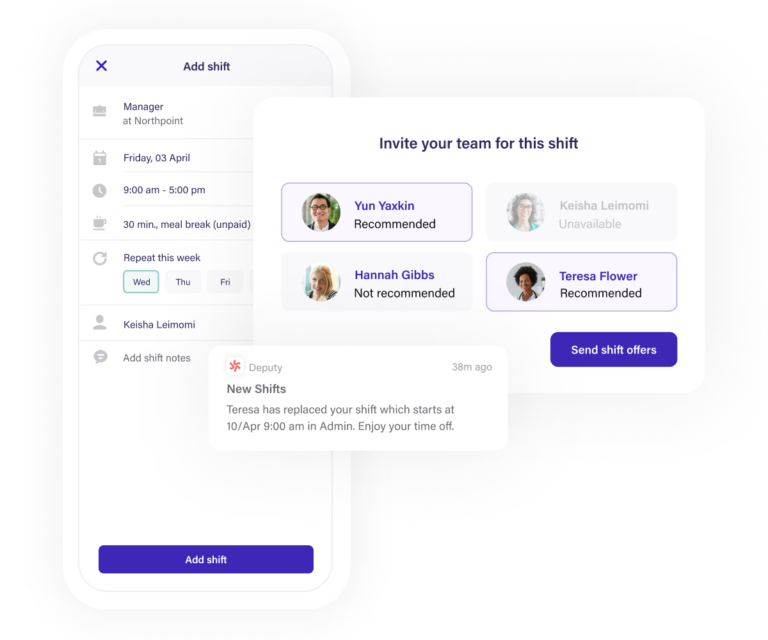
Key Features
- Employee Scheduling: Deputy allows managers to create, manage, and update employee schedules easily using a drag-and-drop interface, with options for recurring shifts and templates.
- Time & Attendance Tracking: Employees can clock in and out using the app, with options for biometric (face recognition) and GPS-based attendance tracking.
- Shift Planning & Management: Shift swapping, availability management, and shift notifications are supported, enabling flexibility for employees and ease of management for employers.
- Payroll Integration: Deputy integrates with payroll systems like Xero, ADP, and QuickBooks, automating payroll data collection from employee attendance and timesheets.
- Task Management: Managers can assign tasks to employees, track completion, and set deadlines through the app, improving operational efficiency.
- Mobile Access: The mobile app allows employees to manage their schedules, submit time-off requests, and communicate with team members. Managers can also approve shifts and track attendance on the go.
- Compliance Management: Ensures scheduling complies with local labor laws, including break rules, overtime, and other regulations.
- Workplace Communication: A built-in communication tool allows for messaging and updates, keeping teams connected and informed.
- Demand Forecasting: Helps businesses predict staffing needs based on historical data, ensuring optimal staff coverage without overstaffing.
- Reports & Analytics: Detailed reporting and analytics tools for managers to track labor costs, attendance, and productivity in real time.
Mobile App
Integrationen
$3.50 to $4.90 per employee per month • Trial: Yes • Free Plan: Yes.
Pros
Easy Scheduling: The drag-and-drop schedule builder makes creating and managing employee shifts very simple and efficient.
Automated Time Tracking: Features like GPS tracking and facial recognition reduce the risk of time theft and ensure accurate attendance records.
Integrations with Payroll: Seamless integration with popular payroll software, reducing manual entry and the chance for errors.
Mobile-Friendly: Employees can manage schedules, request time off, and track shifts from their smartphones, enhancing flexibility.
Real-Time Notifications: Both managers and employees get real-time notifications about shift changes, open shifts, and upcoming tasks, improving communication.
Labor Law Compliance: Deputy helps ensure compliance with local labor laws, saving businesses from potential legal issues.
Cost-Effective for Small Businesses: Deputy is affordable and provides excellent value, especially for small to medium-sized businesses needing efficient scheduling.
Shift Swapping & Flexibility: Employees can swap shifts with ease, reducing managerial involvement in minor shift changes.
Demand Forecasting: Accurate forecasting tools help businesses optimize staff levels and control labor costs.
Cons
Limited Advanced Features: For large businesses with complex operations, Deputy might lack some advanced HR, project management, or payroll features that bigger platforms offer.
Learning Curve for New Users: While intuitive, some features may have a learning curve for first-time users, especially when managing a large number of employees.
Lack of Customization: Some users may find limitations in customizing reports and specific workflows.
Mobile App Bugs: Some users have reported occasional bugs or performance issues with the mobile app, though these are typically resolved with updates.
Limited Task Management: The task management feature is basic and may not be sufficient for businesses needing comprehensive task-tracking tools.
Over-Reliance on Internet Connection: Deputy is cloud-based, so it requires a stable internet connection. If internet access is interrupted, it can disrupt time tracking and scheduling.
Cost for Larger Teams: While affordable for small businesses, the cost can rise for larger teams, as it charges per user per month.
9. Freshteam
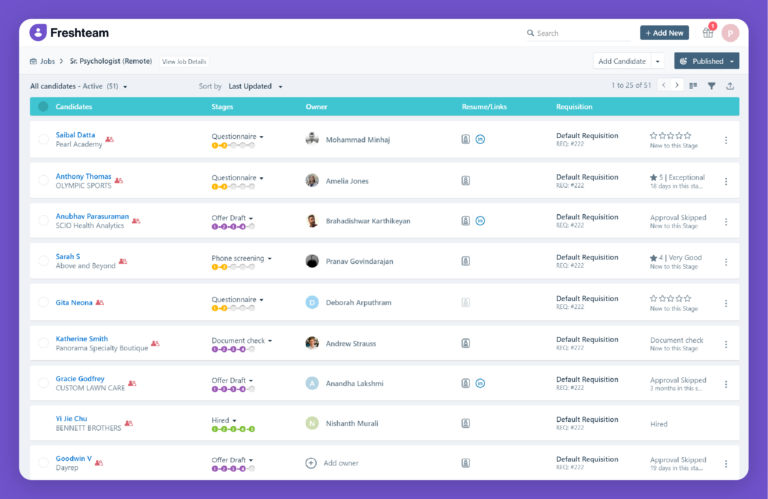
Key Features
Workflow
Mobile App
Integrationen
$1.20 to $4.80 per employee per month • Trial: Yes • Free Plan: Yes.
Pros
User-Friendly Interface: Intuitive design makes it easy for HR teams and employees to use without extensive training.
Comprehensive HR Suite: Covers a wide range of HR tasks, from recruitment to onboarding, employee data management, and leave tracking.
Applicant Tracking: Simplifies recruitment by centralizing job postings, applicant tracking, and collaboration with hiring managers.
Time-Off Management: Automates leave requests and approvals, making it easier for HR teams to manage employee time off.
Customizable Workflows: Flexibility to create custom workflows that suit the unique needs of different organizations.
Employee Self-Service: Empowers employees to manage their own information, reducing the administrative burden on HR teams.
Mobile Access: The mobile app allows HR tasks to be managed on the go, ideal for remote or mobile workforces.
Org Charts: Visual representation of the company hierarchy helps employees understand reporting lines and team structures.
HR Reporting: Provides valuable insights into HR processes through detailed reports and analytics.
Scalable: Works well for small businesses and scales effectively as the company grows.
Cons
Limited Customization for Reports: While reporting is available, the customization options for advanced analytics may be limited for some organizations.
Cost for Advanced Features: Some advanced features, like in-depth reporting and advanced workflow customization, may require higher-tier pricing plans.
Complexity with Large Teams: For larger organizations with complex needs, certain processes like onboarding or applicant tracking may require more manual effort to customize.
Limited Payroll Features: Freshteam does not have built-in payroll features, so users may need to rely on integrations with payroll systems.
Mobile App Limitations: While useful, some users report that the mobile app does not offer the full range of features available on the desktop version.
Learning Curve for Advanced Features: While the interface is user-friendly, more advanced features like custom workflows or detailed analytics may have a learning curve.
10. ADP Workforce Now
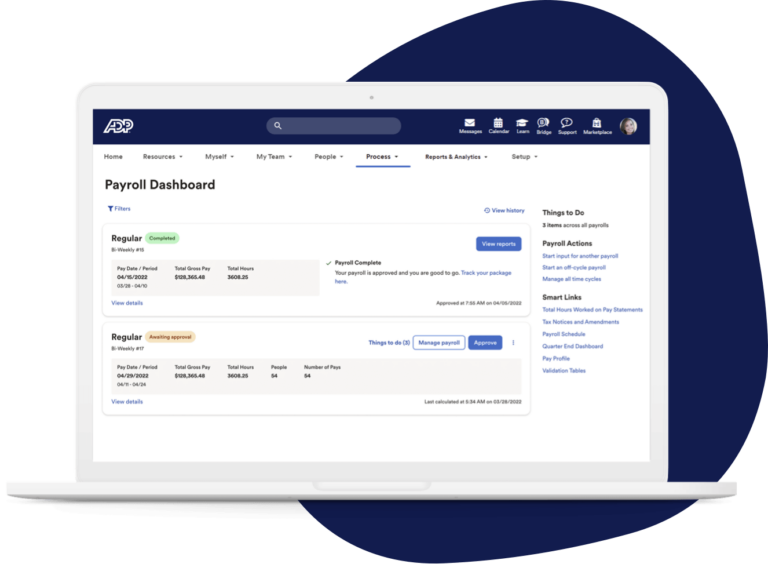
Key Features
Mobile App
Workflow
HR Dashboard
$20 to $25 per employee per month • Trial: Yes • Free Plan: No.
Pros
Comprehensive HR Solution: Covers a wide range of HR tasks, from payroll to benefits, in one platform.
Scalability: Suitable for businesses of various sizes, with customizable features for growing companies.
User-Friendly: Offers a clean and intuitive interface, making it easy for HR professionals and employees to use.
Compliance Assistance: Automated updates help businesses stay compliant with changing regulations.
Advanced Analytics: Provides in-depth reporting and analytics to assist in data-driven decision-making.
Mobile Accessibility: The mobile app offers flexibility for users to access features on the go.
Integration Capabilities: Can integrate with other software solutions like accounting and ERP systems.
Employee Self-Service: Empowers employees to manage their own payroll, benefits, and HR-related tasks.
Cons
Cost: Can be expensive, especially for small businesses, with additional fees for extra features.
Complex Implementation: The initial setup and implementation process can be time-consuming and complicated.
Customer Support: Some users report slow response times and inconsistent support experiences.
Learning Curve: Due to the vast array of features, there can be a steep learning curve for new users.
Customization Limitations: While scalable, customization options might not meet the needs of all organizations.
Frequent Updates: Regular system updates may disrupt workflows or require users to adapt to new changes quickly.